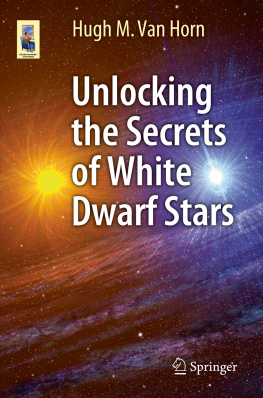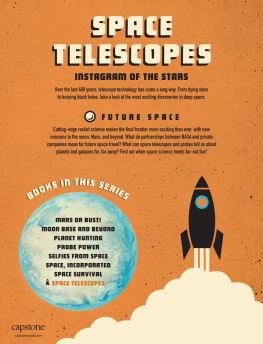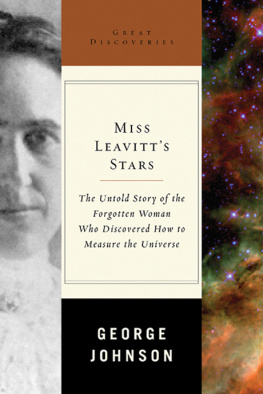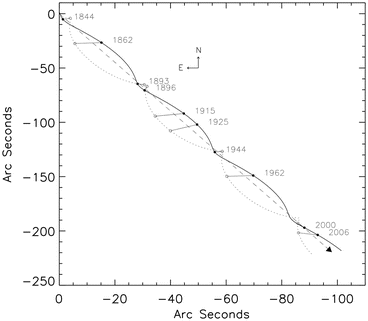1. The First Clues
Friedrich Wilhelm Bessel (17841846; see Figure ) discovered the first clue that pointed to the existence of a strange new class of stars, which we now call white dwarfs. Although he recognized that his finding was important, neither he nor any other scientist in the early nineteenth century had the remotest idea that dramatic advances in science and technology and a revolution in fundamental physics would be required before these stars could be understood.
Figure 1.1
Friedrich W. Bessel. Public domain image courtesy Wikimedia Commons ( http://commons.wikimedia.org/wiki/File:Friedrich_Wilhelm_Bessel.jpeg )
At the beginning of the nineteenth century, astronomers knew almost nothing about the structures of the stars. They did know by comparing their own measurements of the positions of stars in the sky against determinations made by Ptolemy in Egypt nearly 2,000 years earlier and those of the ancient Greeks centuries still further back into the pastthat some of the supposedly fixed stars actually moved across the sky. However, they did not know how far away they were, or how big they were, or what they were made of, and they did not know how much power a star actually radiates to produce the starlight we see on Earth.
During the first half of the nineteenth century, astronomers made all of their observations by eye directly at the telescope, as photography had not yet been invented. Astronomy was thus a demanding discipline, especially in northern Europe, where Bessel worked. A clear night was also a cold night, particularly during the winter months. It required a true passion for the science to be willing to spend night after night in a sometimes bitter-cold observatory, with an eye glued to a telescope eyepiece, to make astronomical observations.
Bessel had not started out to be an astronomer. Instead, he began working as a clerk in a merchants office in Bremen, in the northern German state of Hanover. However, he was very much interested in navigation and astronomy, and as he studied books on these subjects his passion for astronomy grew. He eventually gave up his business position to become an assistant in Amtmann Schroeters private astronomical observatory in Lillienthal, some 10 km from Bremen. Bessel proved to be adept in practical matters of physical measurement and computing, and he was naturally gifted in mathematics, later inventing a new class of special functions now called Bessel functions in solving a problem in planetary motions.
In 1810, the 26-year-old Bessel was selected to found a new astronomical observatory in Knigsberg, located in Bavaria, near Bamberg in central Germany, some 500 km south of Bremen. There he initiated a careful reduction of a lengthy series of observations published more than half a century earlier by British astronomer James Bradley. Bessel was especially careful in analyzing the unavoidable residual errors in the observations, and his results, published in 1818, set a new, high standard for the reduction of astronomical data.
In 1820, Bessel installed a meridian circle at the observatory in Knigsberg. This device consisted of a graduated circle fixed perpendicularly upon the horizontal axis of an instrument used to observe transits of stars across the meridian.. By moving the telescope slowly and steadily, an observer could make a star follow the horizontal wire of the reticle exactly, and by listening to the ticking of the observatory clock he or she could estimate in tenths of a second the moment the star passed the vertical wire. Bessel was a pioneer in the field of precision astronomy using this instrument and was recognized as one of the preeminent astronomers of his day.
Bessels goal and the main focus of the ablest astronomers during the early nineteenth century was to obtain accurate positions of thousands of stars in an effort to build up a reference frame for the celestial coordinates of all stars. These measurements, and similarly accurate determinations by other leading astronomers, had a number of important byproducts. One was the first measurement of the parallax of a star, the apparent shift in the position of a nearby star against the background of more distant stars produced by the orbital motion of Earth around the Sun during the year.
By measuring the parallax angle and knowing the distance from Earth to the Sun termed the astronomical unit or au it was possible for the first time to determine the distances to the nearest stars by triangulation. Bessels 1840 measurements for the star 61 Cygni revealed a parallax of 0.348 seconds of arc (0.348) with a mean error of 0.14", giving the distance to this star as 590,000 au or in more convenient units for measuring stellar distances 2.9 parsecs. In 1870, astronomer William L. Elkin (18551933), then at Yale University Observatory in New Haven, Connecticut, found the parallax of Sirius to be 0.38, putting it at a distance of 543,000 au, or 2.63 parsecs. An angular measure of one second of arc is equivalent to the apparent diameter of a nickel at a distance of approximately 4 km, which illustrates just how demanding these measurements were.
By 1844, Bessels very accurate positional measurements had shown that the bright stars Sirius and Procyon both exhibited irregularities in their motions across the sky (see Figure ). Instead of moving steadily, as expected for an isolated star, each star oscillated about a straight-line path.
Figure 1.2
Variations in the path of Sirius across the sky, as charted by Jay Holberg from historical data. The solid curve marked by the filled circles represents the relative motion of Sirius (now called Sirius A), while the dotted line and open circles represents the positions of Sirius B. The dashed diagonal line shows the motion of the center of mass and is the path Sirius would have followed if it were not part of a binary system. Reproduced with Holbergs permission
On August 10, 1844, Bessel wrote to Sir John Herschel in England about this discovery, and Herschel promptly published a translation in the Monthly Notices of the Royal Astronomical Society . If we were to regard Sirius and Procyon as double stars, Bessel wrote, these changes in their motions would not surprise us However, if this were the correct explanation, why were the companion stars not seen, as they were in other binary systems? This was the first clue to the existence of an unusual new class of star.
Bessel died of cancer in Knigsberg in March of 1846, only 2 years after his seminal discovery, and Christian August Friedrich Peters (18061880) succeeded him as director of the Knigsberg Observatory. In 1851, Peters systematically extended Bessels analysis of the proper motions of Sirius and Procyon. From his new analysis, which included many additional observations and improved corrections to the data, Peters found that the so-far-unseen companion to Sirius had an orbital period of 50 years, moved in a highly elliptical orbit, and in 1841 had most recently passed its closest approach to Sirius.
At the time Bessel was announcing his discovery of an unseen companion to Sirius, on the other side of the Atlantic Ocean a Boston tinkerer named Alvan Clark (18041887; see Figure ) began a career as a world-famous optician and telescope maker. Seven years later, he founded Alvan Clark & Sons, a firm dedicated to the production of first-class lenses and astronomical refracting telescopes, that is, telescopes made using lenses rather than mirrors.










